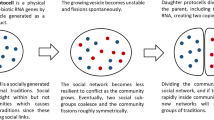Conclusion
The epistemological restructuring goes much beyond the controversy between the relativists and the universalists. It makes us realize that the basic principle of biological, social and some physical processes is increase of heterogeneity and symbiotization. It requires us to see heterogeneity not as deviation from the average but as indispensable components in the system; not as source of conflict but as source of symbiosis and mutual benefit. Furthermore, it goes beyond the concept of division of labor and considers heterogeneity as interactive network which contributes to further heterogenization, symbiotization and cultural change instead of maintenance of the status quo. It sees heterogeneity not as an instrument of evolution which is assumed to have a universal direction, but as a producer of unpredetermined directions of evolution. It sees culture or elements of culture as generating new needs and goals rather than regarding them as internally satisfactory. And it prompts us to develop a science of finding symbiotic combinations among alternative ways the heterogeneous elements can select, rather than watching unsymbiotic combinations defeat themselves.
Similar content being viewed by others
Author information
Authors and Affiliations
Rights and permissions
About this article
Cite this article
Maruyama, M. Heterogenistics and morphogenetics. Theor Soc 5, 75–96 (1978). https://doi.org/10.1007/BF01880861
Issue Date:
DOI: https://doi.org/10.1007/BF01880861



